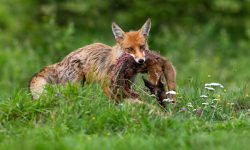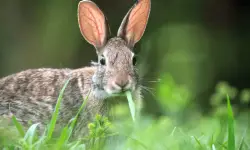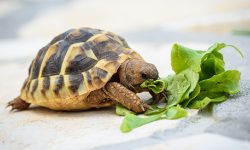Skunks are members of the Mephitidae family and are primarily found throughout North and South America. Their diet is one of their most defining survival traits. Unlike predators that rely on hunting or herbivores that depend on plants alone, skunks can eat nearly anything edible they come across.
Their sharp claws allow them to dig for insects and roots, while their keen sense of smell helps them locate hidden food sources underground. Skunks are nocturnal foragers, venturing out at dusk and returning to their dens before dawn. Their adaptability means they can live comfortably in forests, grasslands, agricultural fields, and even urban areas—anywhere food is abundant.
Let’s explore the 20 foods that make up the bulk of a skunk’s diet.
20 Foods That Help Skunks Thrive in the Wild

1. Insects
Insects are a skunk’s favorite food and make up a large portion of their diet during spring and summer. They eat beetles, grasshoppers, crickets, and larvae found under logs or in soil.
These insects provide vital protein and fats, fueling their nighttime foraging adventures. Skunks are excellent diggers, often leaving small cone-shaped holes in lawns as they hunt for grubs.
2. Grubs
Grubs—soft-bodied larvae of beetles—are a delicacy for skunks. They dig through lawns and garden beds to find these juicy insects, which are packed with protein.
While homeowners may find the digging frustrating, this natural behavior helps control destructive grub populations, making skunks a form of biological pest control.
3. Earthworms
Earthworms are another high-protein, easy-to-digest meal for skunks. After rainfall, skunks take advantage of the moist ground to scoop up worms crawling to the surface.
Worms not only provide nutrition but also hydration due to their high water content, making them a staple during dry periods.
4. Small Mammals
Skunks occasionally hunt small mammals such as mice, voles, and shrews. Although they’re not fast hunters, their stealth and digging abilities help them catch these prey in nests or burrows.
Small mammals supply protein and fat necessary for growth, reproduction, and preparation for winter months.
5. Frogs and Amphibians
Skunks living near wetlands or ponds often feast on frogs, toads, and salamanders. Amphibians are easy to catch and provide both nutrients and hydration.
This part of their diet helps skunks thrive in environments where insects and fruits are less available, especially in early spring.
6. Bird Eggs
Bird eggs are another seasonal food skunks enjoy. They locate ground nests using their sharp sense of smell and eat both eggs and sometimes chicks.
While this may sound harsh, it’s a natural part of the food chain, and skunks help control bird populations, preventing overpopulation in certain habitats.
7. Snakes
Although not common, skunks occasionally eat small snakes. Interestingly, some skunk species are resistant to snake venom, allowing them to prey on smaller, venomous snakes safely.
This rare but fascinating adaptation adds to their ecological role as pest regulators in various ecosystems.
8. Fish
In areas near streams or lakes, skunks scavenge for fish. They eat both dead fish found along shorelines and live ones caught in shallow water.
Fish provide essential omega-3 fatty acids that contribute to healthy fur and energy storage. Coastal or river-dwelling skunks rely on this food source during warmer months.
9. Carrion
Like many omnivores, skunks are scavengers. They often feed on carrion—dead animals left behind by predators or found near roads.
This behavior may seem unpleasant, but it plays a crucial ecological role in cleaning up the environment and preventing the spread of disease.
10. Crayfish
Crayfish are a protein-rich meal found in creeks and ponds. Skunks dig them out of shallow mud or hunt them at the water’s edge during nighttime.
Crayfish offer nutrients similar to insects and amphibians, making them a valuable food source for skunks living near aquatic habitats.
11. Fruits
When summer arrives, skunks develop a sweet tooth. They eat a wide range of fruits such as apples, grapes, berries, peaches, and plums.
Fruits provide natural sugars for quick energy, hydration, and vitamins that support immune health. Skunks are often spotted under fruit trees collecting fallen fruit.
12. Berries
Berries—especially blackberries, raspberries, and blueberries—are among a skunk’s favorite foods. These small fruits are rich in antioxidants, helping skunks stay healthy and strong.
They also act as seed dispersers, helping plants reproduce as they move between feeding areas.
13. Vegetables
Skunks often raid gardens to feed on vegetables like corn, tomatoes, and beans. These provide fiber, water, and trace minerals.
While gardeners might find this frustrating, it’s evidence of the skunk’s adaptability and their ability to find nutrition in human-modified environments.
14. Roots and Tubers
Using their strong claws, skunks dig up roots and tubers such as wild carrots, potatoes, and other underground plants. These foods are rich in carbohydrates and minerals that support energy during colder months.
Roots become particularly important in autumn when insects and fruits decline.
15. Nuts and Seeds
Skunks eat acorns, sunflower seeds, and other nuts they find in forests or gardens. Nuts provide fats that are essential for energy storage before winter.
Their foraging also contributes to seed dispersal, helping forest ecosystems regenerate naturally.
16. Corn
Corn is one of the most commonly eaten crops by skunks. They’ll raid cornfields or gardens for fresh ears of corn, especially during late summer.
Corn provides carbohydrates and calories that help skunks build fat reserves for winter hibernation or dormancy.
17. Pet Food
In urban and suburban areas, skunks frequently eat leftover pet food left outside at night. Dog and cat food contain meat and grains that mimic a balanced omnivorous diet.
While this helps them survive in human-dominated areas, it can encourage unwanted encounters. Securing pet food indoors is recommended to prevent dependency.
18. Garbage and Compost
Skunks are notorious scavengers, often raiding garbage cans for leftovers. They eat discarded fruits, bread, meat scraps, and other food waste.
Though this shows their adaptability, human food isn’t ideal for skunks. It can cause digestive problems and reduce their natural foraging instincts.
19. Honeybees and Larvae
Believe it or not, skunks eat honeybees. They scratch at hive entrances, prompting bees to come out, then swat and eat them quickly. The larvae inside beehives are a particularly rich source of protein.
This behavior makes skunks both a pest to beekeepers and a fascinating example of resourcefulness in the wild.
20. Mushrooms and Fungi
Mushrooms and other fungi round out the skunk’s diet, especially in damp forest environments. They consume edible species found on the ground, gaining minerals and hydration.
These fungi contribute trace nutrients that help skunks maintain their energy and fur quality through changing seasons.
Seasonal Feeding Patterns
Skunks’ diets shift with the seasons to match food availability:
Spring – Protein and Rebuilding Energy
After winter dormancy, skunks focus on insects, worms, and small animals to replenish energy. Fresh vegetation begins to appear, giving them variety.
Summer – Abundance and Variety
Warm months offer the most diverse diet. Insects, berries, fruits, and vegetables dominate. Skunks gain weight during this time to prepare for cooler weather.
Autumn – Fat Storage
As temperatures drop, skunks turn to nuts, roots, and high-calorie foods like corn and carrion. These help them build the fat needed for winter survival.
Winter – Scarcity and Scavenging
In very cold regions, skunks become less active, relying on stored fat or scavenging carrion and garbage when necessary. Their metabolism slows, conserving energy until spring returns.
Nutritional Benefits of a Diverse Diet
A skunk’s omnivorous diet ensures they receive all the nutrients needed for survival:
- Protein from insects, amphibians, and small mammals builds muscle and energy.
- Carbohydrates from fruits, corn, and roots provide quick fuel.
- Fats from nuts and scavenged meat support body warmth and energy storage.
- Vitamins and Minerals from berries and plants strengthen their immune system.
This well-rounded diet keeps skunks agile, healthy, and ready for seasonal changes.
How Skunks Forage
Skunks use their powerful sense of smell to locate food both above and below ground. Their long claws allow them to dig efficiently for insects, roots, and larvae. At night, they travel slowly but purposefully, covering large areas in search of meals.
They often follow familiar feeding routes and return to areas rich in food. When they find an abundant source—like a compost pile or berry bush—they may stay nearby for several nights.
In urban areas, skunks adapt quickly to human presence, scavenging garbage cans, pet bowls, and bird feeders while remaining largely nocturnal to avoid conflict.
The Role of Skunks in the Ecosystem
Skunks are unsung heroes of pest control. By eating insects, grubs, rodents, and even venomous snakes, they help maintain natural balance and protect crops. Their scavenging also keeps ecosystems clean by removing carrion and waste.
In addition, skunks contribute to seed dispersal, spreading plant life through their droppings after consuming fruits and berries. Despite their smell, they are beneficial neighbors in the web of life.
FAQs About Skunk Diets
What do skunks eat the most?
Insects and grubs make up the largest portion of their diet, especially during spring and summer.
Do skunks eat meat?
Yes, skunks eat small mammals, birds, fish, and carrion, but they also consume plenty of plant material.
Do skunks eat fruit and vegetables?
Absolutely. They love berries, apples, corn, and garden vegetables.
What do skunks eat in winter?
During winter, skunks eat less and rely on stored fat, occasionally scavenging for carrion or garbage.
Do skunks eat pet food?
Yes, they’ll eat cat or dog food left outdoors. It’s best to remove it at night to prevent attracting them.
Are skunks good for the environment?
Yes. They control pests, recycle organic material, and help spread seeds—making them ecologically valuable.
Conclusion
Skunks may have a bad reputation for their defensive spray, but their role in nature is far more positive than most realize. These adaptable omnivores eat everything from insects and small animals to fruits, roots, and nuts—keeping ecosystems balanced and thriving.
Their flexible diet allows them to survive across climates and habitats, proving that they are not just survivors but vital contributors to the natural world. By understanding what skunks eat, we can better appreciate their place in the environment and learn to coexist with them peacefully.
So the next time you spot a skunk wandering under the moonlight, remember—it’s not looking for trouble. It’s simply searching for its next meal, doing nature’s work one bite at a time.






